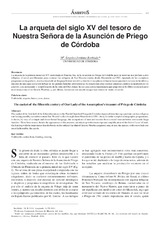La arqueta del siglo XV del tesoro de Nuestra Señora de la Asunción de Priego de Córdoba
The casket of the fifteenth century of Our Lady of the Assumption’s treasure of Priego de Córdoba
Autor
Jordano Barbudo, M. Ángeles
Editor
Asociación de Estudios de Ciencias Sociales y HumanidadesFecha
2011Materia
EmbriachiArqueta
Hueso
Caza
Danza
Casket
Bone
Hunting
Dancing
METS:
Mostrar el registro METSPREMIS:
Mostrar el registro PREMISMetadatos
Mostrar el registro completo del ítemResumen
La arqueta de la primera mitad del XV custodiada en Nuestra Sra. de la Asunción de Priego de Córdoba pasó de tener un uso profano a otro religioso al servir posiblemente para contener las reliquias de San Nicasio traídas desde Masstricht en 1581. Apartada de los complejos programas iconográficos, revela a través de un lenguaje formal sencillo y directo en sus placas de hueso las ocupaciones ociosas de hombres y mujeres de una capa social por debajo de las grandes familias aristocráticas. Se relacionan estas escenas amorosas, junto a la aparición de los amorini, con un trasunto y simplificación de la corte del Dios Amor; las de caza con la importancia que adquirieron los libros especializados en el tema como el de Gastón Phoebus; y, por último, las danzas con una de las que más estuvo de moda: el carole. The casket of the first half of the fifteenth century in the Parish Church of Priego de Córdoba it passed from having a profane use to a religious one having possibly served to contain San Nicasio’s relics brought from Maastricht in 1581. Away from the complex iconographic programmes, it shows, by way of a simple and direct formal language, the occupations of men and women from a social stratum below aristocratic large families. These love scenes, beside the appearence of the amorini, are taken up with a transcript and simplification of the God of Love’s Court; the hunting with the importance that the books in the subject like that of Gaston Phoebus acquired; and, at last, the dances, with one which was most fashionable: the carole.

